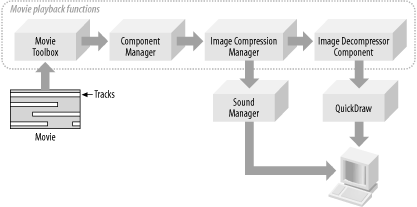The QuickTime API
The QuickTime API is large and complex, and the underlying API’s original native heritage makes it especially hard for a Java developer to get a handle on it. Fortunately, the QuickTime for Java bindings help you write your application, but they can be difficult to understand without first examining the native layer.
Native Origins
QuickTime’s architecture is based on the original Mac OS APIs, in which each API cluster was referred to as a “toolbox” or a “manager.” This section looks at the overall architecture of QuickTime and walks through some of the fundamental building blocks. This book cannot explore every nuance of QuickTime, but this section should help you understand how all the pieces fit together.
A few basic packages provide the conceptual underpinnings for QuickTime: Movie Toolbox, Image Compression Manager, Image Decompressor Manager, and Component Manager. A set of predefined components provides much of the implementation. Figure 10-3 shows how these elements relate to an application that is playing a movie.

Figure 10-3. QuickTime architecture
The Movie Toolbox
A native application’s primary interface to QuickTime is the Movie Toolbox. This API set lets you store, retrieve, and manipulate time-based data stored in QuickTime movies. A single movie may contain several types of data. For example, a movie that contains video information might include both ...
Get Mac OS X for Java Geeks now with the O’Reilly learning platform.
O’Reilly members experience books, live events, courses curated by job role, and more from O’Reilly and nearly 200 top publishers.

